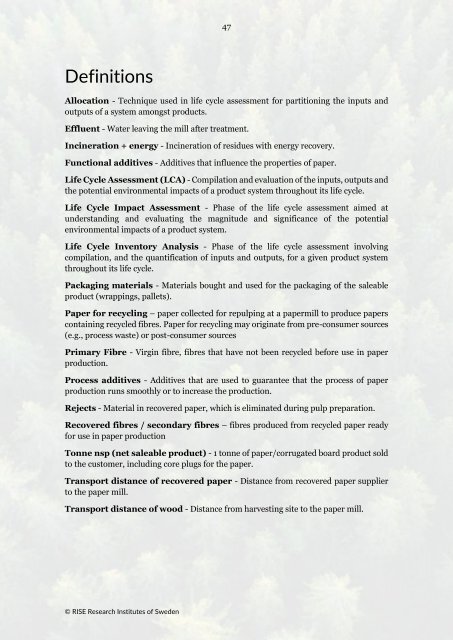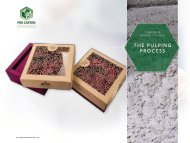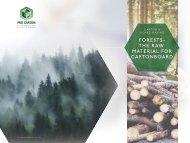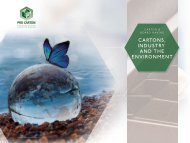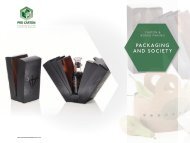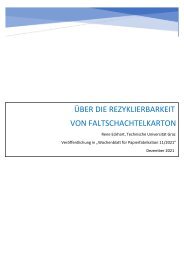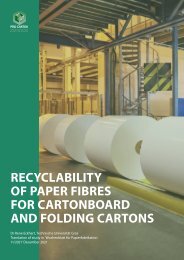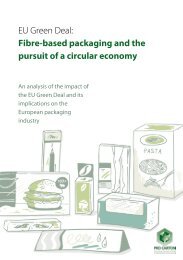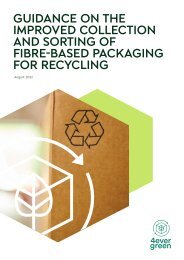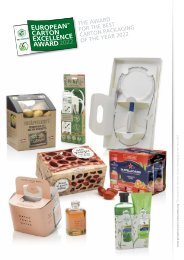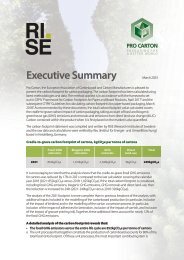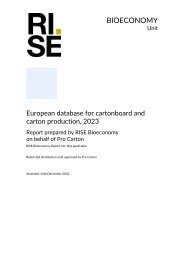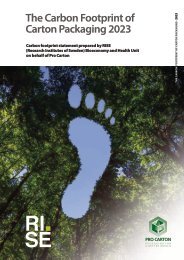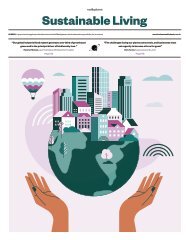European Database for Cartonboard and Carton Production 2023
You also want an ePaper? Increase the reach of your titles
YUMPU automatically turns print PDFs into web optimized ePapers that Google loves.
44<br />
the mill per tonne of virgin cartonboard <strong>and</strong> a 7% reduction in fossil carbon dioxide<br />
emissions arising at the mill per tonne of recycled cartonboard<br />
• Fossil carbon dioxide emissions from fuels consumed at converting operations have been<br />
reduced by 38% in 2021 compared to 2018.<br />
• Total water input per tonne of recycled cartonboard is reduced by 33% from 14.43 m 3 per<br />
tonne to 9.73 m 3 per tonne.<br />
• There has been an improvement in efficiency of board use at the converting plants. In<br />
2021, 1.169 tonnes of cartonboard were required to produce 1 tonne of cartons, compated<br />
to 1.245 tonnes of cartonboard per tonne of cartons required in 2018.<br />
Sustainable <strong>for</strong>est management<br />
There is currently no life cycle impact assessment methodology <strong>for</strong> biodiversity impacts<br />
of <strong>for</strong>est management to produce primary fibres <strong>for</strong> fibre-based products. Nevertheless,<br />
biodiversity impacts are an essential element of <strong>for</strong>est industry products. Sustainable<br />
<strong>for</strong>est management practices have been developed to protect <strong>and</strong> maintain the ecosystem<br />
services in managed <strong>for</strong>ests <strong>and</strong> plantations. The voluntary sustainable <strong>for</strong>est<br />
management certification schemes have been designed to address relevant practices that<br />
help protect ecosystem services such as biodiversity or those that are impacted by l<strong>and</strong><br />
use <strong>and</strong> their implementation has been verified through an accredited, independent third<br />
party. These practices set a proxy <strong>for</strong> mitigating l<strong>and</strong> use impacts <strong>and</strong> protecting<br />
biodiversity.<br />
The data collection revealed that >80% of the pulp wood used <strong>for</strong> the production of<br />
corrugated base papers by the companies returning the survey was certified as being<br />
sourced from sustainable managed <strong>for</strong>ests. Predominantly, primary fibres are FSC or<br />
PEFC certified. A similar proportion of the purchased pulp is also certified <strong>and</strong> third<br />
party verified as being sourced from sustainable managed <strong>for</strong>ests.<br />
Details of the specific countries of origin <strong>and</strong> species of wood used are not provided in<br />
this report. The data provided by incomplete <strong>and</strong> when reviewed it was not deemed<br />
representative of the complete situation.<br />
Conclusions<br />
This report presents the gate-to-gate life cycle inventories <strong>for</strong> the production of<br />
cartonboard, manufactured primarily from primary fibres, the production of<br />
cartonboard manufactured primarily from recovered fibres, the conversion of<br />
cartonboard into blank cartons, (including die cutting, creasing, printing <strong>and</strong> where<br />
applicable folding/gluing) <strong>and</strong> an aggregated dataset, which considers the production of<br />
cartonboard <strong>and</strong> the conversion of this cartonboard into cartons.<br />
The datasets represent the weighted average <strong>European</strong> situation <strong>for</strong> each of the processes<br />
according to the market <strong>and</strong> technology situation in 2021. The datasets are based on<br />
primary data collected directly from the mills <strong>and</strong> convertors operating the processes.<br />
Participation in the surveys <strong>for</strong> cartonboard production was high, with a significant<br />
increase in the number of sites participating <strong>and</strong> the proportion of <strong>European</strong> production<br />
covered. Participation in the survey <strong>for</strong> carton converting was also significant, with data<br />
received from twenty-five converting sites. Although this was fewer sites compared to the<br />
© RISE Research Institutes of Sweden


